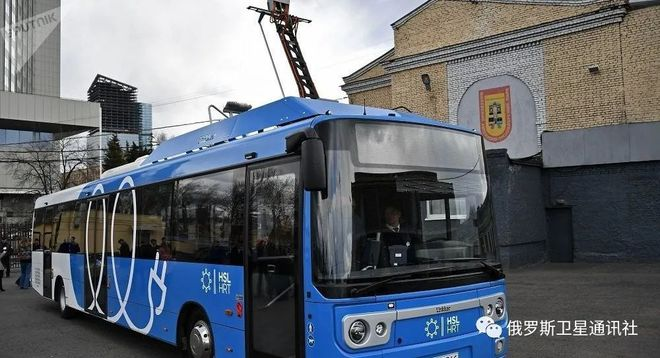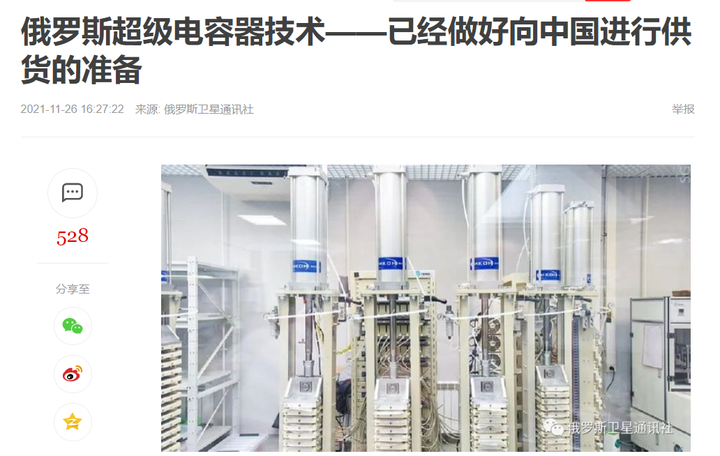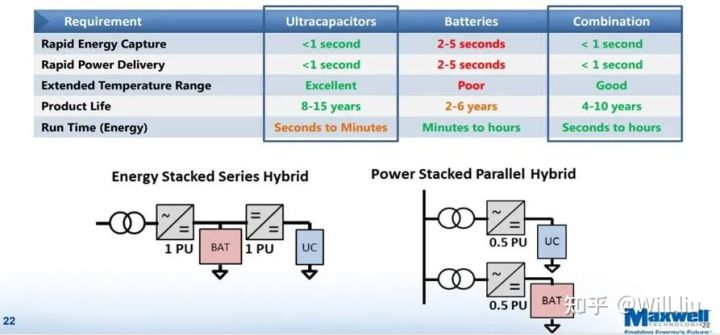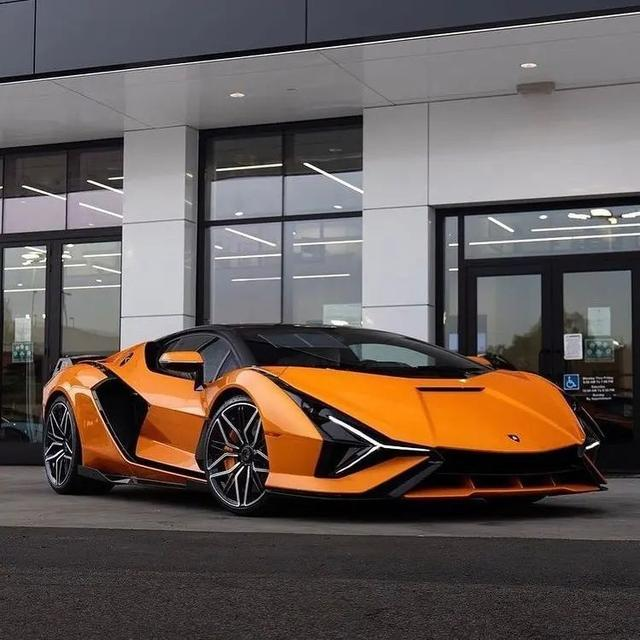First, let’s briefly introduce supercapacitors. According to the energy storage mechanism, the most commonly used supercapacitors are electric double layer supercapacitors and Faraday pseudocapacitor supercapacitors.
Electric double layer supercapacitor
Commonly referred to as EDLC (electromechanical double layer capacitor) , its structure is similar to that of a lithium power battery, with a positive electrode/separator/negative electrode arrangement.

However, although the structure is similar to a lithium power battery, unlike a lithium power battery, the storage of electrical energy does not require a chemical reaction , but a purely physical transfer of electric charge . After charging, electrical energy is stored as charge in the electric field between the plates. When discharging, current flows rapidly from the electric field. Whether charging or discharging, supercapacitors theoretically do not consume or dissipate energy.
Because the charging and discharging of the electric double layer capacitor supercapacitor does not require chemical reaction, but directly transfers the charge, so it has an extremely fast charging and discharging speed. Fast charging is a good thing, but too fast discharging is actually not a good thing. Because most vehicles need to ensure battery life, energy storage equipment is required to continuously release energy.
Electric double-layer supercapacitors have large charge/discharge capacity, high efficiency, long cycle life, ultra-low temperature resistance, and high energy recovery efficiency, and have great potential for development in future energy storage systems. However, the current stage cannot support high voltage, so how to improve the working voltage has become the key to improving the energy density of electric double layer capacitors.
Faraday Pseudocapacitor Supercapacitor
The principle is to utilize highly reversible chemisorption/desorption or oxidation/reduction reactions occurring at and near the electrode surface in the potential range for energy storage. It seems that the principle is similar to the chemical reaction of lithium batteries, but this charge-discharge behavior is closer to that of a capacitor.
During charging, an example of an electrolyte solution diffuses to the electrode/solution interface under the action of an applied electric field. It enters the bulk phase of the active oxide on the electrode surface through the electrochemical reaction at the interface. Because the electrode material is an oxide with a large specific surface area, a large amount of electric charge is stored in the electrode through an electrochemical reaction.

During discharge, electrons entering the oxide are re-entered into the electrolyte, while the stored charge is released through an external circuit.
Faraday pseudocapacitors have a higher theoretical specific capacitance than electric double layer supercapacitors, and under the premise of the same electrode area, Faraday pseudocapacitors are 10-100 times that of electric double layer capacitors. At the same time, the energy density is higher and the specific capacity is larger. However, because of the chemical reaction process involved, the cycle stability is not as good as that of electric double-layer supercapacitors . In addition, due to technical reasons, the production cost is high, the utilization rate of electrode materials is low, and the rate performance is poor.
Back to topic content:
Why don’t electric cars use super capacitors instead of lithium batteries? Why can supercapacitors be used as energy containers for large buses?
In fact, in the past century, lithium power batteries are far from reaching the current industry consensus. The United States, Europe, Japan, and Russia are all trying to use a variety of power sources in electric vehicles, such as fuel cells and supercapacitors.
Since 1992, the U.S. Department of Energy and USABC have cooperated with a number of companies, such as MAXWELL and GE, to jointly develop carbon-based electric double-layer supercapacitors.
Among them, the supercapacitor developed by Russia has a specific power of 3KW/kg and a cycle life of more than 100,000 times, and its technology ranks in the forefront of the world.

Early Russian city buses using supercapacitors can travel 10-20 kilometers on a single charge. (Use the pantograph to connect the upper wire for charging.)
There has been related news before. At the Zhongguancun Forum-Technology Trading Conference, Moscow State Institute of Iron and Steel and Alloys demonstrated the electrode materials used in supercapacitors.

Domestic supercapacitor buses first appeared in Shanghai.

The Shanghai supercapacitor bus was put into use in 2006. The initial power was 5 kWh. At that time, the supercapacitor was still stored at the bottom of the carriage. It had to stop every two or three stops. At the bus stop, use the charging pile to charge it for half a minute. Continue to drive… One can imagine the feelings of the driver and passengers at that time…
The current super capacitor car (third generation in 2019) has been upgraded from 5 degrees to 40 degrees, and the super capacitor is set on the roof for easy connection and charging.

40 kWh of electricity can maintain a single trip in the city (30-40 kilometers), and the charging pile is set at the terminal. Every time the super capacitor bus returns to the terminal, it only takes less than 10 minutes to fully charge. electricity.
Therefore, supercapacitor buses use the characteristics of electric double layer supercapacitors with large charge/discharge capacity, high efficiency, long cycle life, and high energy recovery efficiency, and because of the fixed route and short mileage, every 30 to 40 kilometers is driven. For a single trip, when the driver is resting, it can be fully charged within ten minutes. And the cycle life is more than 100,000 times, far exceeding the one or two thousand times of lithium power batteries, and the cost is relatively low.
However, if it is loaded on a car, because of its low energy density, the current commercial lithium power battery, even the lithium iron phosphate battery with low system energy density, has 120-150wh/kg, while the commercial ternary lithium battery has 180 wh/kg. -200wh/kg system energy density. However, the energy density of current commercial electric double-layer supercapacitors is only about 10wh/kg, which is only 4%-5% of the energy density of mainstream lithium power batteries.
Taking the 2022 Xpeng P7 with a range of 480 kilometers as an example, the lithium power battery is a lithium iron phosphate battery with an energy density of 125wh/kg and a battery energy of 60.2kwh.
System energy density = battery system charge/battery system weight
The approximate weight of the entire lithium battery pack is 482 kg.

For the electric double layer supercapacitor with a system energy density of 10wh/kg, the energy provided by the 482kg supercapacitor can only allow the P7 to run 38 kilometers. If you want to run 480 kilometers, according to the battery energy of 60.2kwh, the weight of the supercapacitor will reach 6 tons, but if the weight of this 6 tons is taken into account, regardless of how to accommodate the size of this giant, it needs to be larger. The driving force and power of the battery is a heavier battery… (The above is only calculated by energy density, weight, and energy, and other factors are not considered.)
It is conceivable that a pure electric car that can only run less than 40 kilometers on a single charge, even if the charging time is only seven or eight minutes, it can be charged 100,000 times, which is not enough for home use. After all, vehicles are not only used for commuting, but also occasionally run down medium and long distances. You can’t run 20 kilometers before you start worrying about where the next charging pile is… So this kind of small vehicle, because of the energy density of the supercapacitor system, cannot afford medium and long-range battery life.
The existing medium-sized tourist bus in the scenic spot has a short running distance, a fixed route, and can be charged at both ends, which can also be used for this kind of super capacitor. And large vehicles are no problem. For example, the weight of the bus itself reaches 10-15 tons, so adding a three- or four-ton flat battery pack can easily accommodate it in both space and weight.
However, although the existing supercapacitors cannot be used as the main battery to ensure battery life, they are still qualified as a booster battery. For example, the lithium power battery is used as the main driving power, and the super capacitor is responsible for driving in emergency situations (quick discharge), and the deceleration of the vehicle can also easily and quickly charge the super capacitor to achieve kinetic energy recovery.

In this way, supercapacitors can also be used on small vehicles, such as motorcycles, two-wheeled electric vehicles, electric vehicles, and hybrid vehicles.
Braking energy recovery, the supercapacitor can be used for instantaneous recovery of large current , and when rapid acceleration and climbing are required, the power of the supercapacitor can be quickly released to obtain high power and power in a short period of time, thereby bringing Come to a whole new driving experience.

In this way, supercapacitors can also be mixed with lithium power batteries, or mixed with engines to improve vehicle power.
For example, Lamborghini’s new hybrid sports car “Sián” (a flash of lightning) , which is the world’s first hybrid sports car using “super capacitors”, has a maximum power of 819 horsepower and a top speed of more than 350 kilometers per hour. , 0-000 acceleration takes only 2.8 seconds. It is loaded with a 6.5-liter V12 engine, and with the braking energy stored in the super capacitor, the motor + engine can provide instant acceleration and high torque, successfully making this sports car enter the two-second club.

(Picture source network, invade and delete!)
References:
1. https://www.163.com/dy/article/GPOA 2OR20530W6DQ.html
2. https://sghexport.shobserver.com/html/baijiahao/2021/09/22/544092.html _
Source: Zhihu www.zhihu.com
Author: Will.liu
[Zhihu Daily] The choice of tens of millions of users, to be a big cow of new things in the circle of friends.
click to download
There are 13 more answers to this question, see all.
Further reading:
This article is reproduced from: http://www.zhihu.com/question/20268843/answer/2518038423?utm_campaign=rss&utm_medium=rss&utm_source=rss&utm_content=title
This site is for inclusion only, and the copyright belongs to the original author.